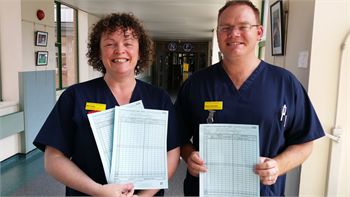Effective education and clinically supportive resources for those involved in the provision of health care is imperative if the risk and burden of AKI is to be successfully reduced. Most secondary care institutions in the UK have adopted the use of AKI management guidelines and many have an outreach nursing team.
The RD&E AKI Outreach nursing team, the first of its kind in the South West, was appointed as a pilot in January 2014. Amongst a number of resources designed to assist the entire multidisciplinary team, they developed an AKI specific safety thermometer combining both medical and nursing care elements, in order to measure staff response to e-alerts and the recognition and response to AKI risk factors.
As well as demonstrating that education plays an important part in developing staff knowledge and performance, the safety thermometer highlighted some serious discrepancies in two of the most commonly utilised resources; 24 hour fluid balance charts and the Early Warning Score (EWS) system. The Fluid balance charts within the trust had undergone a change in the preceding two years. General consultation had been minimal and this, coupled with the fact that the charts were now designed to be totalled at 0700 hours and were printed on white paper, led to an extremely poor reception from and very poor completion by the nursing teams.
A fully interactive pilot to develop a ‘one size fits all’ chart for all adult care areas in the trust was commenced following completion of a baseline questionnaire in April 2015. Trust Nursing staff were constructive in their comments and understood Team AKIs rationale behind amalgamating the use of the two resources. They greatly appreciated Team AKIs wish to work collaboratively and being able to have their opinions heard.
The new blue fluid balance charts were released trust-wide on July 1st 2015.
Changes to the urine scoring element of the trust EWS formed part of a toolkit to identify the deteriorating patient released 1st December 2015. Chart completion has since improved from 14% to 90%

